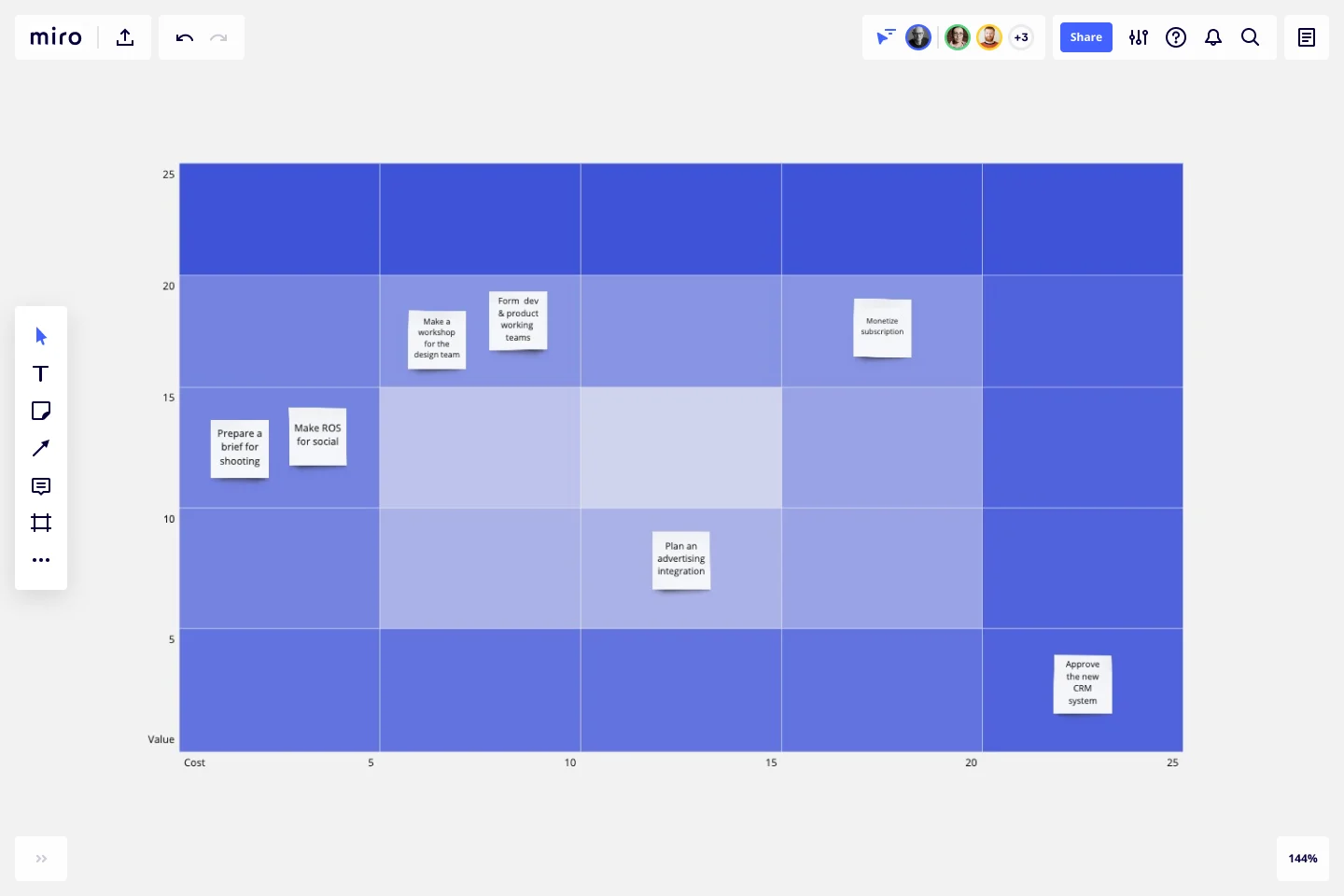Bang for the Buck Template
Use our Buck Template to prioritize epics and stories and identify priorities in the early stages of development as part of your Agile workflow.
Trusted by 65M+ users and leading companies
About the Bang for the Buck template
What is Bang for the Buck?
Bang for the Buck is a strategy for facilitating collaboration between the product manager and development teams. The goal is to prioritize backlog items. Rather than moving through your agenda without prioritizing what needs to get done, the Bang for the Buck model empowers you to identify the costs and benefits associated with various tasks. You can then assign scores to each task based on the “bang for your buck” you can expect to get from the task. With your scores in hand, you can then organize your tasks based on the order in which you can complete them. Finally, graph each task according to cost and value so you can start checking things off of your to-do list.
How does the Bang for the Buck work?
The Bang for the Buck model consists of a graph with the value of your items on the y-axis and the cost on the x-axis. Each axis is organized as a Fibonacci number. Write down the tasks on your backlog. With your teammates, discuss where each item belongs on the graph. The product manager’s job is to focus on the value of the task, while the development team should focus on the cost of the task. These various stakeholders allow you to get multiple perspectives on your tasks. When your graph is finished, you can follow your graphed items in a clockwise order to maximize efficiency.
How do you use the Bang for the Buck template?
Team members can create sticky notes to represent the tasks they have for an upcoming sprint. You can color-code the notes to make it easy to keep track of which tasks belong to which person. Invite your team members to collaborate on the board, using the @mention features and video chat to discuss items in more detail. Any changes made to the board will be visible in real-time.
Who should use the Bang for the Buck template?
Any team that follows the sprint workflow can use the Bang for the Buck template to prioritize tasks for an upcoming sprint. The team may work together to decide on the values for different tasks, with input from the product manager to ensure tasks are assigned the correct value.
Get started with this template right now.
Project Timeline Builder
Works best for:
Timeline, Planning
The Project Timeline Builder template is a powerful tool for planning and managing project timelines. It helps you break down projects into manageable tasks, set deadlines, and track progress. This template ensures you stay organized and meet your project goals efficiently.
Reflection Island: End of Year Team Retro
Works best for:
Retrospectives, Agile Methodology, Meetings
The Reflection Island: End of Year Team Retro template offers a creative and themed approach to retrospectives, perfect for wrapping up the year. It provides elements for reflecting on achievements, challenges, and goals using a tropical island theme. This template enables teams to celebrate successes, learn from setbacks, and set intentions for the upcoming year in a relaxed and enjoyable atmosphere. By promoting reflection and celebration, the Reflection Island: End of Year Team Retro empowers teams to strengthen bonds, boost morale, and start the new year with renewed energy and focus effectively.
Product Ops Canvas
Works best for:
Product Management, Planning
The Product Ops Canvas template helps product managers align product strategies with operational capabilities. By mapping out key operational processes, tools, and metrics, this template fosters alignment between product and operational teams. With sections for identifying bottlenecks and optimizing workflows, it supports continuous improvement in product operations. This template serves as a guide for driving efficiency and scalability in product management processes, enabling teams to deliver high-quality products at scale.
Bull's Eye Diagram Template
Works best for:
Diagrams, Project Management, Prioritization
When you’re a growing organization, every decision can feel like it has make-or-break consequences—which can lead to decision paralysis, an inability to prioritize, inefficient meetings, and even low morale. If that sounds like you, put a Bull’s Eye Diagram to work. True to its name, a Bull’s Eye Diagram uses a model of concentric circles to help companies establish priorities, make critical decisions, or discuss how to remove or overcome obstacles.
2x2 Prioritization Matrix Template
Works best for:
Operations, Strategic Planning, Prioritization
Ready to set boundaries, prioritize your to-dos, and determine just what features, fixes, and upgrades to tackle next? The 2x2 prioritization matrix is a great place to start. Based on the lean prioritization approach, this template empowers teams with a quick, efficient way to know what's realistic to accomplish and what’s crucial to separate for success (versus what’s simply nice to have). And guess what—making your own 2x2 prioritization matrix is easy.
Gap Analysis Template
Works best for:
Marketing, Strategic Planning, Business Management
Consider your team’s or organization’s ideal state. Now compare it to your current real-world situation. Want to identify the gaps or obstacles that stand between your present and future? Then you’re ready to run a gap analysis. This easy-to-customize template will let your team align on what obstacles are preventing you from hitting your goals sooner, collaborate on a plan to achieve those goals, and push your organization toward growth and development. You can focus on specific gap analyses — including for skills, candidates, software, processes, vendors, data, and more.
